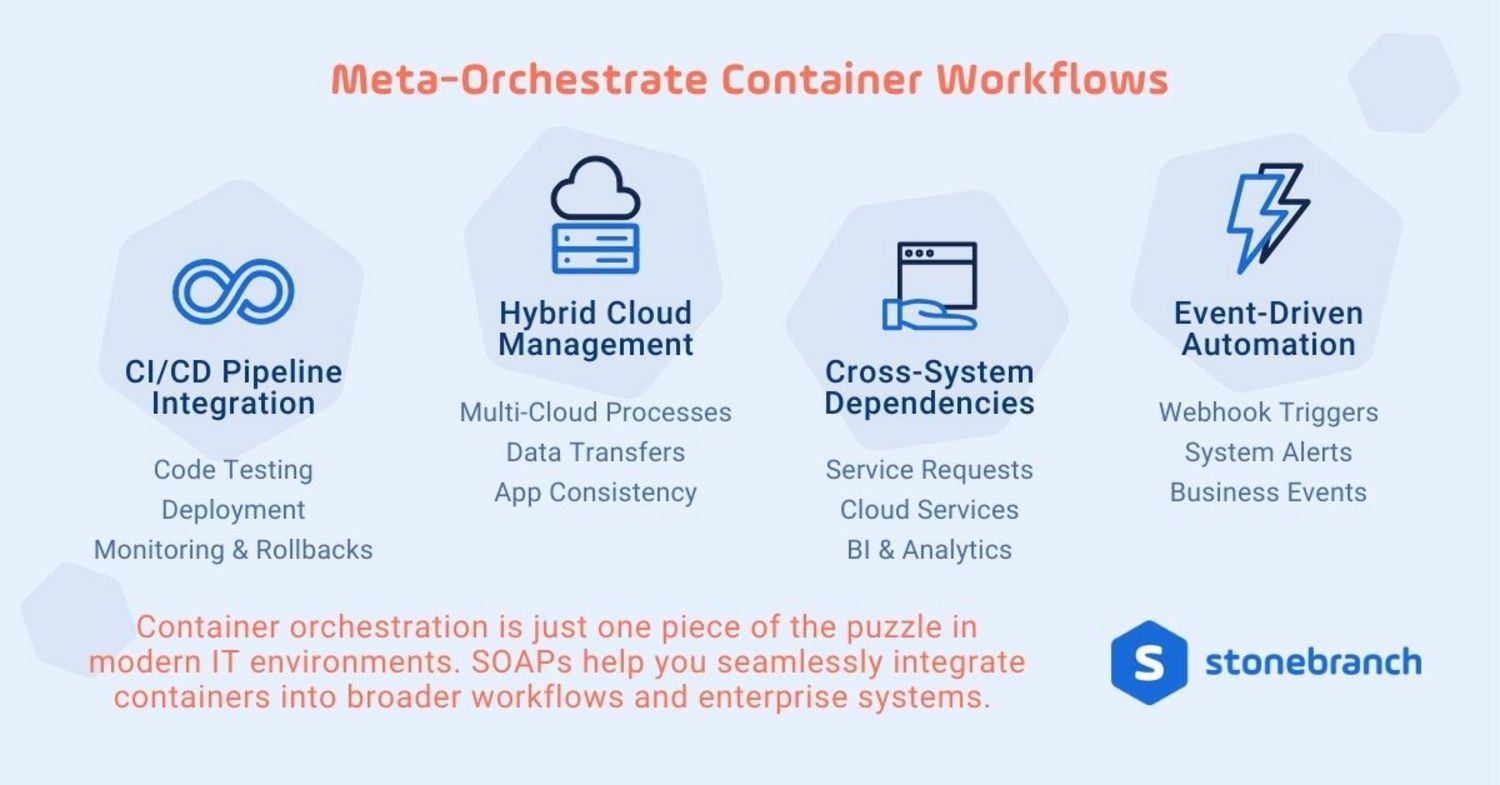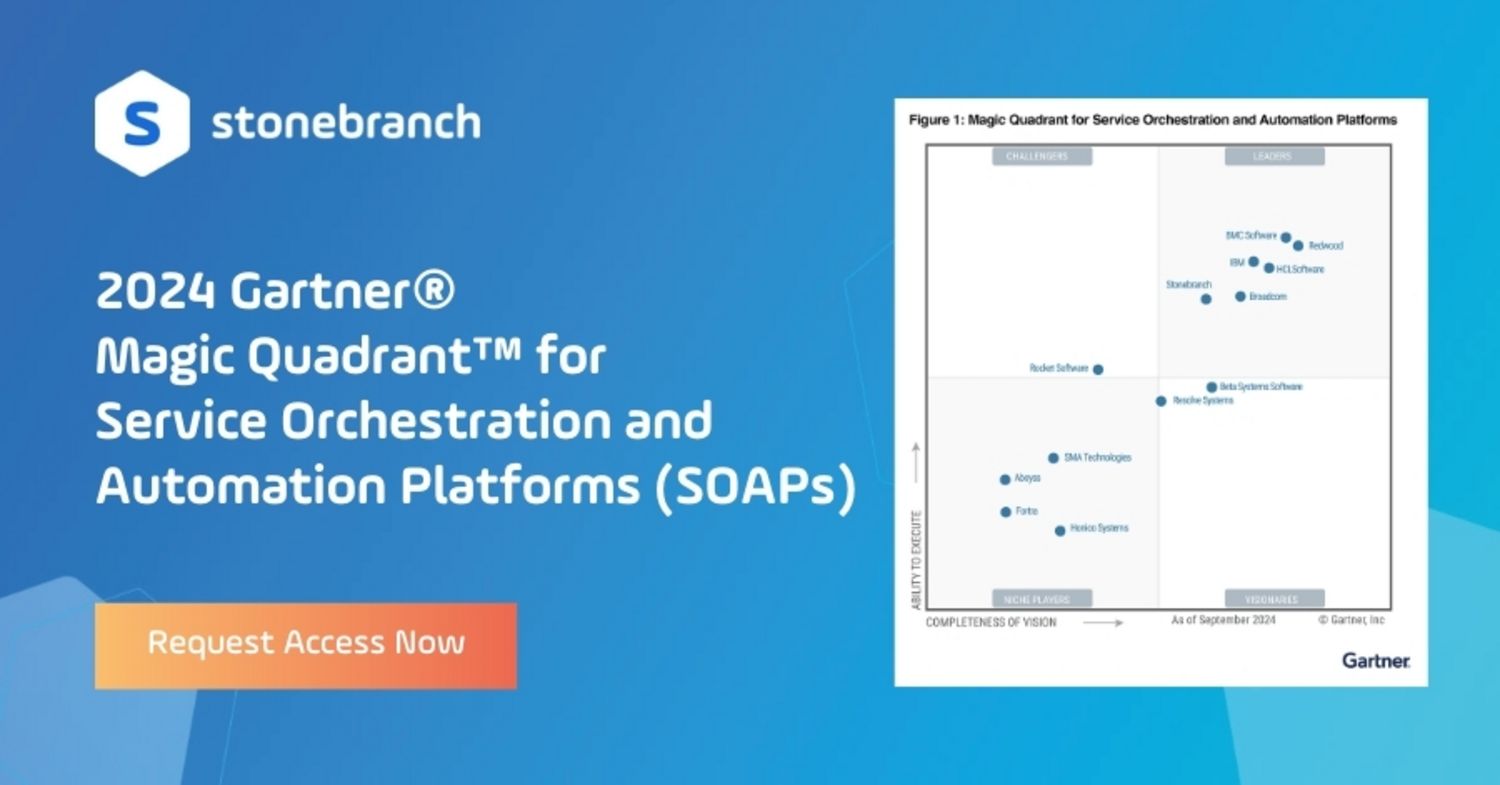What is Container Orchestration?
Container orchestration allows you to seamlessly automate the deployment, scaling, and management of containers and containerized applications — and are an essential part of end-to-end workflows across your hybrid IT environment.

Container orchestration has become a cornerstone of modern IT operations. As organizations adopt containerized microservices and applications to improve scalability and agility, it has become critical to effectively deploy and manage these containers. Container orchestration streamlines the deployment and management of containerized workloads, ultimately easing complexity and ensuring optimal performance in multi-cloud and hybrid environments.
How Container Orchestration Works and Why It Matters
Container orchestration is the automated process of deploying, managing, and scaling containerized applications and microservices architectures. Like a virtual machine, containers encapsulate application code and dependencies for consistency and portability across environments. Unlike a virtual machine, containers only virtualize the software layers — not the underlying machine or operating system.
Organizations use containerization to improve scalability, flexibility, and deployment speed. However, as the number of containers grows, so does the complexity of managing them. It is possible to manually oversee the full lifecycle of containers, which includes:
- Deployment: Placing containers efficiently across available resources.
- Scaling: Dynamically adjusting workloads based on real-time demand.
- Networking: Establishing secure communication between containers and external systems.
- Monitoring: Tracking container performance and health.
- Security: Managing access controls and securing inter-container interactions.
Managing these tasks manually — particularly at scale — becomes unsustainable, which leads organizations to adopt container orchestration tools to automate and optimize the process.
Challenges of Container Orchestration
According to the Cloud Native Computing Foundation, the average user now operates over 20 clusters, often across various environments such as cloud services and data centers. At this scale, managing containers manually introduces significant operational challenges, including:
- Infrastructure Complexity: Containers need to be deployed across a mix of cloud and on-prem environments, each with unique networking, storage, and security requirements.
- Scalability Management: Without automation, adjusting workloads to accommodate traffic spikes or scaling down to optimize costs is time-consuming and error-prone.
- Service Resilience: Manually recovering from container failures, restarts, or service disruptions can lead to downtime and impact business continuity.
- Configuration Management: Each containerized application requires precise configurations, including resource limits, networking policies, and access controls, which can become difficult to track and enforce at scale.
- Security and Compliance: As containers communicate across distributed environments, ensuring consistent security policies, role-based access control (RBAC), and compliance with industry regulations is challenging.
These challenges underscore the need for container orchestrators, which provide automated processes to simplify management and improve reliability.
Benefits of Container Orchestration
Container orchestration solves these challenges by automating critical tasks, ensuring that containers operate efficiently and reliably in production environments. Organizations benefit from:
- Automated Scaling: Dynamically adjust resource utilization based on demand to prevent performance bottlenecks and optimize cost efficiency.
- Resilience and High Availability: Ensure uptime through built-in redundancy, load balancing, and automated failure recovery. When a container crashes, the orchestration platform detects the issue and restarts the container without manual intervention.
- Efficient Resource Utilization: Optimize hardware efficiency by intelligently distributing workloads across available infrastructure, reducing waste and improving performance.
- Simplified Management: Centralize control over complex containerized environments, enabling IT teams to manage deployments, updates, and security policies from a single interface.
By leveraging container orchestration, enterprises can streamline operations, reduce complexity, and improve the agility of their IT environments — making it a critical component of modern application deployment strategies.
Common Container Orchestration Tools
The container orchestration landscape is dominated by several container orchestration platforms. Each offers unique capabilities to efficiently manage all the servers, nodes, and container images involved in containerization. Here are some of the most widely used orchestration services:
- Kubernetes – As the industry standard for open source container orchestration, Kubernetes helps deploy, scale, and manage containerized applications.
- Red Hat OpenShift – Built on Kubernetes, OpenShift is an open source container orchestrator that adds security, developer tools, and multi-cloud support.
- Docker – Docker provides a lightweight, open source approach to containerization, offering portability and simplicity. Additionally, Docker Swarm orchestrates processes across clusters of Docker containers.
- Public Cloud Container Services – Each major cloud provider offers their own managed container orchestration tool to manage container deployments at scale.
- Amazon Web Services (AWS): Amazon Elastic Kubernetes Service (Amazon EKS)
- Microsoft Azure: Azure Kubernetes Service (AKS)
- Google Cloud Platform (GCP): Google Kubernetes Engine (GKE)
Choosing the right container orchestration tool depends on factors like workload complexity, cloud computing strategy, security requirements, and operational expertise. Many enterprises use a mix of these platforms to balance flexibility and control across hybrid and multi-cloud environments.
Orchestrating the Orchestrators with a SOAP
While container orchestrators like Kubernetes and OpenShift provide robust capabilities, enterprises often need a more integrated approach to manage containers within their broader IT workflows. This is where a service orchestration and automation platform (SOAP) can help.
SOAPs play a critical role in connecting containerized workloads with enterprise-wide automation strategies:
- Unify Operations: Manage containerized applications and non-containerized workloads from a single platform.
- Enforce Governance and Avoid Misconfigurations: Dynamically generate and manage configuration files to ensure containerized workloads are deployed with the correct settings.
- Enable Event-Driven Automation: Trigger container jobs based on system alerts, business events, or dependencies.
- Facilitate Multi-Cloud Orchestration: Deploy and manage containers seamlessly across AWS, Azure, GCP, and on-premises environments.
How a SOAP Meta-Orchestrates Workflows Beyond Container Management
While container orchestration tools like Kubernetes and OpenShift manage containers at the infrastructure level, SOAP platforms provide enterprise-wide automation. They enable orchestration beyond containers by integrating with ITSM tools, CI/CD pipelines, and multi-cloud environments. In doing so, SOAPs amplify the benefits of container orchestration across the broader enterprise landscape. The following use cases are just a few examples.

CI/CD Pipeline Integration
DevOps teams can use a SOAP to automate containers in their software development lifecycles:
- Testing: Spin up containerized environments to test code for new releases.
- Deployment: Manage rollouts across different environments.
- Monitoring and Rollbacks: Link orchestration with monitoring tools to detect issues and trigger rollbacks.
Hybrid Cloud Management
For organizations operating in hybrid environments, a SOAP can help:
- Orchestrate Multi-Cloud Workflows: Manage Kubernetes clusters across different cloud providers.
- Synchronize Data Across Systems: Move data between cloud-based and on-premise applications.
- Enhance Portability: Ensure applications run consistently across various infrastructures.
Cross-System Dependencies
Containerized applications rarely operate in isolation. A SOAP enables:
- Integration with ITSM Tools: Initiate workflows based on incidents or service requests.
- Connecting to Cloud Services: Embed container jobs into broader cloud-native workflows.
- Enhancing Analytics Pipelines: Process containerized data alongside BI and analytics tools.
Event-Driven Automation
By supporting event-based workflows, a SOAP can trigger tasks based on:
- Webhooks: Automate deployments when code commits occur.
- System Alerts: Scale or restart containers based on system performance thresholds.
- Business Processes: Respond to real-time business events.
The Future of Container Orchestration
As businesses increasingly adopt emerging technologies, their container orchestration strategies will continue to evolve. Organizations need solutions that support agility, flexibility, and scalability, especially as containerized workloads become more central to enterprise operations. Here are several key trends shaping the future of container orchestration:
- Edge and IoT Container Orchestration: Managing containerized workloads closer to data sources allows organizations to process data locally, which reduces latency, optimizes bandwidth, and improves real-time performance. Advanced container orchestration platforms will increasingly support deployments across distributed networks, from centralized data centers and cloud providers to remote IoT and edge devices.
- AI-Driven Orchestration: AI and machine learning will likely enhance container orchestration by enabling intelligent resource allocation and proactive fault management based on predicted workload fluctuations and anticipated resource demands. AI-based orchestration will result in optimized resource utilization, lower operational costs, and improved application availability and performance.
- AI-Enhanced Observability and Monitoring: AI-driven observability features will enable proactive monitoring and anomaly detection across containerized environments to improve the speed of issue resolution, streamline troubleshooting processes, and contribute to more resilient and reliable container deployments.
- Serverless and Container Integration: Serverless containers will simplify operations by enabling developers to deploy containerized applications without directly managing underlying infrastructure. This model will provide granular scalability — allowing containers to spin up rapidly in response to events while eliminating idle capacity costs associated with traditional infrastructure.
By integrating container orchestration tools with a SOAP, organizations gain comprehensive control over their containers. SOAP solutions help businesses extend orchestration beyond containerized environments, ensuring cohesive integration across hybrid and multi-cloud landscapes, ITSM platforms, DevOps pipelines, and data workflows. Ultimately, this integrated approach empowers businesses to streamline operations, reduce complexity, and drive greater agility — embedding container orchestration seamlessly into their broader IT strategy.
How Stonebranch Supports Container Orchestration
Simply put, manual container management is impractical for enterprise-scale applications. Stonebranch Universal Automation Center (UAC) is a powerful SOAP that integrates containers seamlessly into enterprise automation strategies. With prebuilt integrations for Kubernetes, Red Hat OpenShift, and Docker, as well as AWS, Azure, and GCP, Stonebranch enables organizations to unify container management, optimize resource utilization, and drive IT efficiency.
By leveraging event-driven automation and cross-system integrations, Stonebranch empowers businesses to achieve scalable and resilient container orchestration within a broader automation framework.
Start Your Automation Initiative Now
Schedule a Live Demo with a Stonebranch Solution Expert






